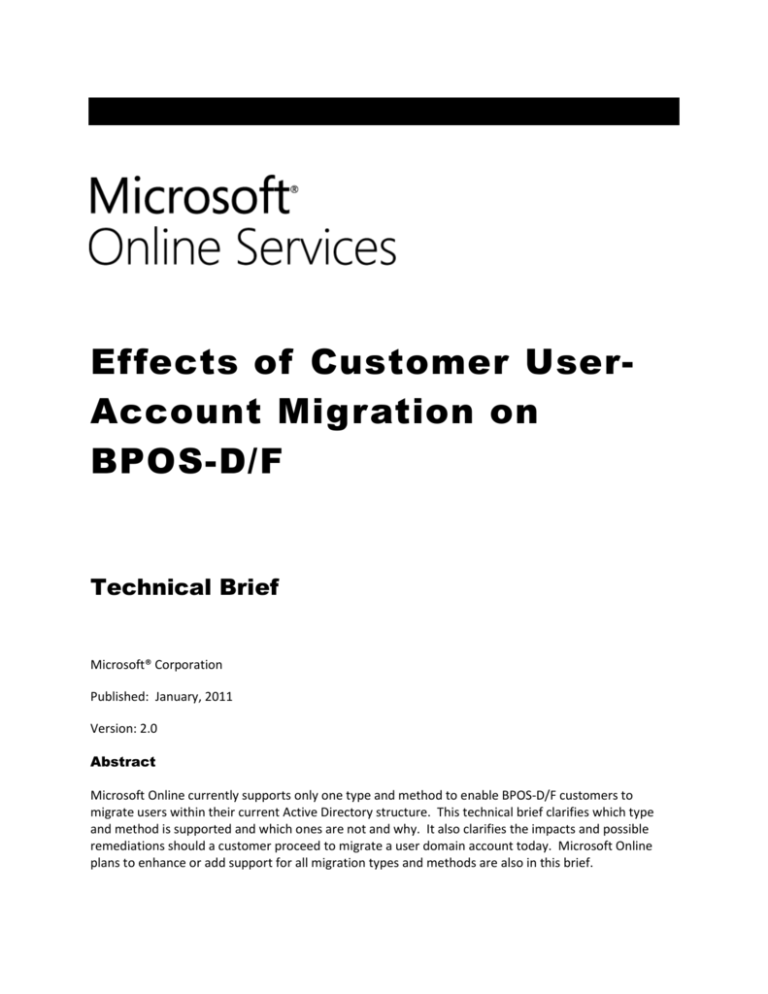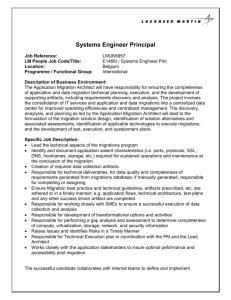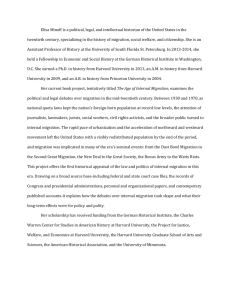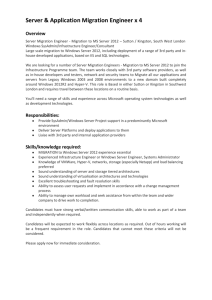Tech Brief - Effects of Customer User Account Migration
advertisement

Effects of Customer UserAccount Migration on BPOS-D/F Technical Brief Microsoft® Corporation Published: January, 2011 Version: 2.0 Abstract Microsoft Online currently supports only one type and method to enable BPOS-D/F customers to migrate users within their current Active Directory structure. This technical brief clarifies which type and method is supported and which ones are not and why. It also clarifies the impacts and possible remediations should a customer proceed to migrate a user domain account today. Microsoft Online plans to enhance or add support for all migration types and methods are also in this brief. Table of Contents Introduction .................................................................................................................................................. 3 Audience ................................................................................................................................................... 3 Context ...................................................................................................................................................... 3 Purpose ..................................................................................................................................................... 3 Domain Account Migration Types & Methods ............................................................................................. 4 Definitions ................................................................................................................................................. 4 Supported versus Unsupported Migrations.............................................................................................. 4 Why Some Migrations Are Unsupported .................................................................................................. 5 Impacts of Performing Supported & Unsupported Migrations ................................................................ 6 Future Support of Migration Types, Methods .......................................................................................... 8 Summary ..................................................................................................................................................... 10 Recommendations .................................................................................................................................. 10 References............................................................................................................................................... 10 Glossary ................................................................................................................................................... 10 Frequently Asked Questions ....................................................................................................................... 12 Appendix ..................................................................................................................................................... 14 Supported Migration Scenario ................................................................................................................ 14 Unsupported Migration Scenario............................................................................................................ 15 Microsoft Confidential Page 2 of 16 Introduction Audience This document is intended for existing and future BPOS-Dedicated and Federal (BPOS-D/F) customers and specifically organizations and individuals who manage and administer the customer’s Active Directory as part of consuming Exchange, Lync (previous known as Office Communicator) and SharePoint Online services. Context In order for users within a given customer to consume BPOS-D services, their user accounts must reside within the customers Active Directory (AD). User accounts are placed in a distinct unit of administration and resource grouping known as an AD domain. One or more domains are created within an AD forest, which act as a security boundary for an organization and defines the scope of authority for administration. There are situations when customers may need or want to migrate one or more user accounts between domains within the same forest (Intra-forest) or across two different forests (Interforest). In doing so and based on the migration methods chosen, this could lead to the disconnection of Microsoft Online services they were subscribed for. Disconnection of services could potentially result in loss of data and reconnection of these services is not currently supported. Purpose The purpose of this document is to clarify the types and methods that Microsoft Online does and does not support for migrating users, either intra or inter forest within their current Active Directory structure. It is also to advise BPOS-D/F customers of the potential consequences should a customer proceed in migrating a user domain account using a migration type and method that MS Online does not support. A brief discussion of Microsoft Online future plans for supporting migration types and methods has also been provided in this document. Microsoft Confidential Page 3 of 16 Domain Account Migration Types & Methods Definitions This document refers to two types of user account migrations: Inter-forest (a.k.a. cross-forest) migration A domain user account is moved from one forest to another. Intra-forest migration A domain user account is migrated to a different domain within the same forest. This type of migration can be made using either the Move or Clone method. Migration methods are not widely known unless your expertise is in domain account migrations. If you are using a domain account migration tool, it may provide the option of selecting which migration method you want to use. Be aware that some tools do not provide the option to choose the migration method, so it is important to understand which migration method is being employed by the tool you are using. Move This method takes the existing Active Directory user object and moves it to the destination forest. Using this method, the user object (objectGUID) remains the same in the new domain but the user’s security identifier (objectSID) changes. Clone (copy) This method takes the existing Active Directory user object, makes a copy of all the object attributes and then deletes the user object. It then creates a brand new user object in the target domain and copies all the attributes to this new user object. Using this method, a new user object (objectGUID) and security identifier (objectSID) are created in the new domain or forest, and a selected set of attributes are copied over from the old to the new user object. Note: This method is generally not recommended for domain migrations within a forest and the reason this is documented here is to explain that this method too will face the same effects as a cross-forest domain move. Supported versus Unsupported Migrations A matrix of migration types and methods is provided below to show which one(s) MS Online currently does and does not support in providing online services to their customers. An unsupported migration method means that MS Online does not have a method (i.e. process, tools, etc.) to automatically reconnect a user object from the source to the target forest or domain if migrated using the respective migration method. The result is that the customer will experience specific negative impacts should they proceed with an unsupported migration method including significant effort to manually reconnect a migrated user and unrecoverable loss of user data. Details of why migration types and methods are currently unsupported and the specific impacts by migration method by online service are provided in the following paragraphs. An Inter-forest migration using the Move method is constrained by Active Directory design. Since a forest is a security boundary, moving across security boundaries means that a new user object is automatically created. AD migration tools only allow an Inter-forest migration to be done via the Clone method. Microsoft Confidential Page 4 of 16 Migration Type Migration Method Inter-forest (a.k.a. cross-forest) Migration Intra-forest Migration Move Clone Not Applicable Unsupported Supported Unsupported Table 1: Currently Supported/Unsupported Migration Types and Methods Why Some Migrations Are Unsupported The challenges with unsupported migration types, methods vary slightly depending on which online service you are discussing. A matrix of unsupported migration types, methods by service is provided below to summarize these challenges with additional detail to follow. Note that while Intra-forest migrations using the Move method are supported by MS Online, they have the same challenges for SharePoint Online that the unsupported migrations have. Refer to the Impacts section of this document for details. Migration Type, Method Challenges Inter-forest or Intra-forest Clone Method Exchange and Lync The objectGUID changes and online service is deprovisioned for (previously known as OCS) migrated user(s). MMSSPP is not able to reconnect original user Online Services object (from source forest/domain) with new user object (target source/domain) so user data is lost. SharePoint Online Services The objectSID is changed. Any direct permission’s for migrated user(s) to SharePoint site collections, document libraries, lists or MySites are broken. LiveMeeting Online Services None Table 2: Challenges of Unsupported Migration Types, Methods MMSSPP uses the objectGUID in order to establish a sync connection between the customer Active Directory and the Microsoft Managed Active Directory. Like each person’s DNA, the objectGUID is unique and all user attributes and permissions associated with this objectGUID are unique. An objectGUID cannot be modified. The Exchange and Lync online services use a user’s objectGUID to provision them to the respective service(s). If a user account is moved between domains or forests using the Clone method, a new user object is created in the target domain/forest and a selected set of attributes are copied over from the original to the new user object. By Active Directory design, when a new user object is created, it is created with a new objectGUID and objectSID. Microsoft Confidential Page 5 of 16 Since MMSSPP associates each user account by its objectGUID, after the move, the connection MMSSPP had with the original user object is broken (post domain account move, the original object is either deleted or moved out of scope). The result is that MMSSPP deletes the corresponding user object in the Managed Active Directory, along with all BPOS-D services (mailbox, Lync profile and Lync contacts) associated with that user object. MMSSPP then creates a brand new objectGUID, objectSID, and a new set of services that include a new mailbox and Lync profile for them. Please note the above scenario assumes that the original object is either deleted or moved out of MMSSPP scope. In the case where the original object still exists and is in MMSSPP scope, this will result in a sync error with the original object still being connected to Microsoft Online services. A new objectSID also has an impact on users who are provisioned to SharePoint Online. Users who have been directly permissioned on to SharePoint site collections, document libraries, lists or MySites will lose access to all of these resources since the objectSID has changed. Users will continue to be able to access resources that were granted permissions via security groups. Today, there is no way for MMSSPP to associate the newly created domain account with the previous one. To add to that, reconnection of services could lead to potential loss of email; entail tedious and time consuming steps per user-account, for which our support team is not staffed for. The specific effects on objectGUID and objectSID during typical user account migration scenarios is shown for both supported and unsupported migrations in the Appendix of this document. Impacts of Performing Supported & Unsupported Migrations MS Online recognizes that there are business scenarios when a domain user account migration or AD forest consolidation is of high importance or urgency from the customer’s perspective. Some common examples are: (1) a user moves geographically, requiring changing membership to a different domain or forest; (2) a user has a change in employee status (such as from contractor to FTE), or (3) a customer wants to consolidate multiple domains/forests, or migrate from a single-label domain to a domain with a fully qualified domain name (FQDN). In this event, MS Online recommends that BPOS-D customer’s either use supported migration types, methods where applicable or defer user account migrations until the needed method is supported. MS Online explicitly recommends that BPOS-D customers DO NOT use the unsupported migration types, methods until such time as they are supported. This is due to the impacts and limited or difficult remediation’s required to resolve problems resulting from doing these unsupported migrations. A summary of the impacts and possible remediation in performing supported and unsupported migrations has been provided in the following table to help ensure BPOS-D customers are aware of them should they choose to move forward with user account migrations. Customers should also note the following: 1. The severity of a listed impact and the associated remediation can be viewed as variable depending on the number of users to be migrated. For example, the impact on an Intra-forest migration using the Move method is that SharePoint permissions may be broken for the migrated user(s). The remediation is to manually restore those permissions once the user is migrated. Having to do this manual action for a small number of users may be perceived as less severe than for a large number of users. 2. When using a domain account migration tool to manage an Intra-forest migration, use extreme care to ensure that the tool is configured to use the Move method, which is the recommended method to use. Some migration software toolsets may offer only the Clone method or use the Clone method as the default setting for user account migrations. Microsoft Confidential Page 6 of 16 3. Please advise your MS Online Technical Account Manager (TAM) or other MS Online representative prior to moving any user accounts. This will enable MS Online to consult as appropriate and be forewarned should any issues occur during the account migrations. Microsoft Confidential Page 7 of 16 Inter-forest, Intra-forest Clone Method Intra-forest Move Method Service Exchange and Lync SharePoint LiveMeeting Exchange and Lync SharePoint LiveMeeting Impact User account is deleted from Managed AD. Service(s) are de-provisioned for that user. Any direct permission’s for migrated user(s) to SharePoint site collections, document libraries, lists or MySites are broken. Users will continue to be able to access resources that were granted permissions via security groups. None None Remediation None. Deleted information is not retrievable. Any direct permission’s for migrated user(s) to SharePoint site collections, document libraries, lists or MySites are broken. Users will continue to be able to access resources that were granted permissions via security groups. None Customers only option would be to manually (remove and add user) reset SharePoint site permissions for each user individually Customers only option will be to manually reset (remove and add user) SharePoint site permissions individually for each user. N.A N.A N.A Table 3: Impacts in Performing Unsupported Migrations Future Support of Migration Types, Methods MS Online is planning and coordinating changes among the online service teams that will enhance currently supported migration methods, types and enable currently unsupported migration methods, types to be supported. Migration Type Migration Method Inter-forest (a.k.a. cross-forest) Migration Intra-forest Migration Move Clone Not Applicable Supported Supported Supported Table 4: Future Supported, Unsupported Migration Types and Methods The specific changes being planned are: Add functionality to MMSSPP that will automatically reconnect migrated domain user accounts provisioned within the Exchange and Lync online services Provide a self-service tool for SharePoint Online that will help customers reset SharePoint permissions for users that have had domain account migrations The MMSSPP changes are targeted for implementation as part of the MMSSPP 11.1 release. This release is expected to be available by the end of June, 2011. The target for the SharePoint Online selfservice tool is also by the end of June, 2011. Microsoft Confidential Page 8 of 16 BPOS-D customers will be required to perform certain steps so that the additional user account migration capabilities being implemented will work as intended. MS Online will be providing documentation to BPOS-D customers that outline those steps by the end of Q1, 2011. Microsoft Confidential Page 9 of 16 Summary Recommendations MS Online recommends to BPOS-D customers, that where applicable and possible, to: 1. Complete any forest/domain consolidations or large-scale user account migrations prior to onboarding to BPOS-D online services or defer them until MS Online completes their planned MMSSPP and SharePoint changes in Q2, 2011. 2. Use supported migration types, methods or defer user account migrations until the needed method is supported. 3. NOT use the unsupported migration types, methods until such time as they are supported. This is due to the impacts and limited or difficult remediation’s required to resolve problems resulting from doing these unsupported migrations. 4. Ensure they are aware of respective impacts and available remediation’s for chosen migration types and methods References SID versus GUID: http://technet.microsoft.com/en-us/library/cc961625.aspx ADMT Guide: Migrating and Restructuring Active Directory Domains: http://technet.microsoft.com/en-us/library/cc974332(WS.10).aspx Glossary Term Definition Customer Refers to a BPOS-D customer consuming one of more Microsoft Online services. BPOS-D Services Collectively refers to Exchange, Lync and SharePoint for the purposes of this document. Domain A domain is a distinct unit of administration and resource grouping in Active Directory Domain Services (AD DS). Forest An Active Directory forest contains all the domains, sites, and trusts that are part of Active Directory Domain Services (AD DS). The forest acts as a security boundary for an organization, and it defines the scope of authority for administration. By default, a forest contains a single domain, which is called the forest root domain. Intra-forest Migration These are moves between domains within the same forest. Inter-forest Migration These are moves across two different forests. Also known as cross-forest migrations. Security-Identifier (SID) A security identifier (SID) is a unique value of variable length that is used to identify a security principal or security group in Windows operating systems. SIDs can sometimes change. Microsoft Confidential Page 10 of 16 Term Definition Object-Global Unique Identifier (a.k.a. objectGUID or GUID) A GUID is a 128-bit value assigned to every user or group that is unique not only in the enterprise but also across the world. Active Directory uses GUIDs internally to identify objects. The values of other object properties can change, but the ObjectGUID never changes. When an object is assigned a GUID, it keeps that value for life. objectSID (a.k.a. SID) A binary value that specifies the security identifier (SID) of the user. The SID is a unique value used to identify the user as a security principal. Security Principal Active Directory user and computer accounts (as well as groups) are referred to as security principals, a term that emphasizes the security that the operating system implements for these entities. Security principals are directory objects that are automatically assigned SIDs when they are created. MMSSPP Microsoft Managed Solutions Service Provisioning Provider. This is the Identity Sync and provisioning service solution for MS Online services. Migration Method Refer to the way in which a domain user account is migrated. This document considers 2 different Migration Methods; (1) Move; (2) Clone Migration Type Refers to the entities across which the user is being migrated. This document includes 2 different Migration Types: (1) Interforest (a.k.a. cross-forest); (2) Intra-forest Microsoft Confidential Page 11 of 16 Frequently Asked Questions Q1. What specific services are deprovisioned in a non-supported migration? A1. Detailed in the following table: BPOS-Dedicated Service Exchange Online Service Mailbox Mailbox Permissions Impact Deprovisioned Deprovisioned Exchange Active Sync (EAS) Deprovisioned Blackberry Services (BES) Deprovisioned Archiving (ProofPoint) Services Lync Online Service Deprovisioned Lync Profile (contact information) Lync permissions Deprovisioned Deprovisioned SharePoint Online Service Team sites Deprovisioned MySites Deprovisioned LiveMeeting Service No impact MMSSPP attribute Sync Deprovisioned Group Memberships Impact is determined by the options of domain account migration tool. If the tool copies group memberships, there will be no impact. If not, group memberships will be deprovisioned Q2. How are services affected in a supported move? A2. Detailed in the following table: BPOS-Dedicated Service Impact Exchange Online Service Mailbox No impact Mailbox Permissions No impact Exchange Active Sync (EAS) No impact Blackberry Services (BES) No impact Archiving (ProofPoint) Services No impact Lync Online Service Microsoft Confidential Page 12 of 16 Lync Profile Connection No impact SharePoint Online Service Team sites Permissions broken MySites Permissions broken LiveMeeting Service No impact MMSSPP attribute Sync No impact Group Memberships No impact Q3. Is there any 3rd-party software that can help with remediating unsupported migrations? A3. No. Provisioning and deprovisioning of services are tied to MMSSPP and so there is no 3rd party software that can plug into MMSSPP. Q4. Can Microsoft Support help if I make an unsupported migration? A4. No. Microsoft Helpdesk Support does not support these scenarios. Q5. What can I do to remediate the impact if I must make a non-supported migration? A5. Please create a support request and inform your TAM immediately. Q6. Why can’t the SIDhistory be utilized? A6. SIDFiltering is enabled over all Active Directory trust setup between Microsoft and the customer forest(s) or domain(s). This is a Microsoft security requirement. SIDFiltering filters SIDhistory, which is why SIDhistory cannot be utilized. Please note this is in context with BPOS services, SIDhistory can be utilized to access resources within the customer environment . Q7. Why can’t MMSSPP reset SharePoint permissions? A7. MMSSPP only provisions services for Exchange and Lync and does not write to the SharePoint database. Q8. Why is the Live Meeting Service not impacted by these changes? A8. LiveMeeting permissions are permissioned on the LiveMeeting Portal using Security Groups from each domain in the customer environment. As long as the new account is in a domain (which it typically is) that has a security group permissioned on the portal, there will be no impact. In this case, if there is an impact it is because there is no SG or the new account is not a member of this SG. Microsoft Confidential Page 13 of 16 Appendix Supported Migration Scenario Environment Details Single Forest: Contoso.com Child Domain 1: NA.Contoso.com Child Domain 2: Europe.Contoso.com User Details: Name: John Doe Domain: Contoso SID: A ObjectGUID: X Scenario States: Pre-Migration MMSSPP has established a sync connection with Contoso\John Doe using objectGUID X and has provisioned, Microsoft Online Mailbox and Lync profile using SID A Contoso\John Doe’s SharePoint permissions are associated to SID A The Migration Customer uses domain migration tool to migrate John Doe from domain 1 na.Contoso.com to domain 2 europe.Contoso.com Post Migration After the migration, Europe\John Doe has the same objectGUID X but the SID changes to SID B. At the next sync cycle, MMSSPP will find John Doe with objectGUID X has a new SID and so it will sync the new SID and reset the Exchange and Lync permissions with the new SID B to the object in the Microsoft managed Active Directory. No impact to Exchange or Lync services. However, since Europe\John Doe SID has changed, he loses permissions to all SharePoint sites he previously had access to, because his SID has changed to B. Microsoft Confidential Page 14 of 16 John JohnDoe Doe(Disabled (Disabled logon logonaccount) account) Linked Linkedmailbox mailbox SID: SID:AA OCS OCSProfile: Profile: SID SID A A One-way Forest level Trust SIDFiltering Enabled John JohnDoe Doe (enabled (enabledlogon logon account) account) SID: SID:AA ObjectGUID:X ObjectGUID:X MMSSPP Synchronization & Provisioning engine NA.Contoso.com NA.Contoso.com Contoso.com Contoso.com SharePoint Team site MySites Document Library & lists John JohnDoe Doe SID: SID:BB ObjectGUID:X ObjectGUID:X SIDhistory:A SIDhistory:A Read Access SID A Europe.Contoso.com Europe.Contoso.com John is delegate of Jane Doe Mailbox Delegation: SID A Send-As permissions: SID A Contoso.mgd.microsoft.com Contoso.mgd.microsoft.com Customer Active Directory Forest Microsoft Online Hosted Forest Figure 2: Currently Supported Migration Scenario Unsupported Migration Scenario Environment Details Forest 1: Contoso.com Forest 2: Blueyonder.com User Details: Name: John Doe Domain: Contoso SID: A ObjectGUID: X Scenario States: Pre-Migration MMSSPP has established a sync connection with Contoso\John Doe using objectGUID X and has provisioned, Microsoft Online Mailbox and Lync profile using SID A Contoso\John Doe’s SharePoint permissions are associated to SID A The Migration Customer uses domain migration tool to migrate John Doe from Forest Contoso to Forest BlueYonder Post Migration After the move, BlueYonder\John Doe has objectGUID Y and SID B At the next sync cycle, MMSSPP will not find John Doe with objectGUID X and so it will delete the object in the Microsoft managed Active Directory, along with all services associated with it Microsoft Confidential Page 15 of 16 MMSSPP will then create a brand new user object for BlueYonder\John Doe and provision a new mailbox and Lync profile. BlueYonder\John Doe also loses permissions to all SharePoint sites he previously had access to because his SID has changed to B. John JohnDoe Doe(Disabled (Disabled logon logonaccount) account) Linked Linkedmailbox mailbox SID: SID:AA OCS OCSProfile: Profile: SID SID A A One-way Forest level Trust SIDFiltering Enabled MMSSPP Synchronization & Provisioning engine SharePoint Team site MySites Document Library & lists John JohnDoe Doe (enabled (enabledlogon logon account) account) SID: SID:AA ObjectGUID:X ObjectGUID:X Read Access SID A Contoso.com Contoso.com John is delegate of Jane Doe Mailbox Delegation: SID A Send-As permissions: SID A Contoso.mgd.microsoft.com Contoso.mgd.microsoft.com Microsoft Online Hosted Forest Customer Active Directory Forest 1 Customer Active Directory Forest 2 Services disconnected, permissions broken John JohnDoe Doe SID: SID:BB ObjectGUID:Y ObjectGUID:Y SIDhistory:A SIDhistory:A BlueYonder.com BlueYonder.com Figure 3: Currently Unsupported Migration Scenario Microsoft Confidential Page 16 of 16







